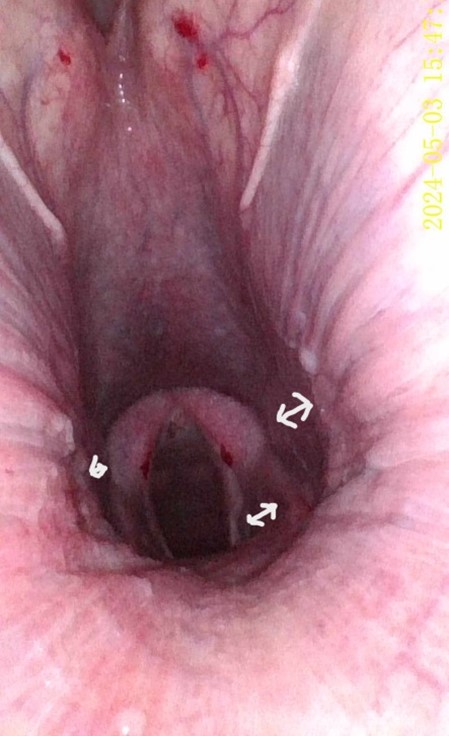Recurrent equine laryngeal alteration associated with compression of nerves in the infra-auricular region similar to Eagle Syndrome in humans
Case report
DOI:
https://doi.org/10.31533/pubvet.v18n09e1649Keywords:
Eagle Syndrome, equine endoscopy, equine ultrasound, horses, respiratory disease in horses, headshakingAbstract
A mare presented headshaking, along with signs of problems in the upper respiratory tract. After a detailed clinical examination, an endoscopic examination was performed and an asymmetry was found to the left of the laryngeal cartilages. Searching for a probable etiology for the endoscopic finding, an ultrasound examination was performed in the infra-auricular region (parotid region) bilaterally and comparatively. The ultrasound examination showed a deviation (on the left side) of the nerve bundle corresponding to the deviation of the cartilages and soft palate, from which we associated the findings with the clinical presentation by the mare and concluded that it was the cause of the problem. Comparing this case, specifically, with Eagle Syndrome in humans, the aforementioned findings were very similar to the syndrome in humans.
References
Budras, K. D., Sack, W. O., & Rock, S. (2003). Anatomy of the horse: An illustrated text. Mosby.
Ducharme, N. G., & Cheethan, J. (2014). Abnormalities of the upper airway. In K. W. Hinchcliff, Kaneps. A J, & R. J. Geor (Eds.), Equine sports medicine and surgery (2nd ed., pp. 549–586). Sauders Elsevier. https://doi.org/10.1016/B978-0-7020-4771-8.00026-0.
Gonçalves, E. S., Nary, H. F., Alvarez, L. C., Oliveira, C. M., & Stanghini, V. (2003). Síndrome de Eagle: estudo radiográfico da incidência de processos estilóides alongados. 22(1), 15–33.
Guzzo, F. A. V., Macedo, J. A. G. C., Barros, R. S. & Almeida, D. C. (2006). Síndrome de Eagle: relato de caso. Revista Paranaense de Medicina, 20(4), 47-51.
Higino, T. C. M., Tiago, R. L. S., Belentani, F. M., Nascimento, G. M. S., & Maia, M. S. (2008). Síndrome de Eagle: Relato de três casos. Arquivos Internos de Otorrinolaringologia, 12(1), 141–144.
Lunas, A. G., Quintana, G. O., Nez Esquivel, V. H., Gutiérrez Velazco, J. L., & Domínguez Carrillo, L. G. (2016). Síndrome estiloideo de Eagle. Acta Médica Grupo Ángeles., 14(4).
Oliveira, A. C. M., & Massucato, E. M. S. (2009). Síndrome de Eagle - Prevalência do alongamento do processo estiloide e calcificação do ligamentoestilo-hioideo. RFO UPF, 14(3).
Ribeiro, R. L., Porto, Í. S., Silva, A. L. A., Araújo, M. M., Silva, W. P., Braga, E. F., Souza, G. C. P., Sousa, M. C. S. R., Silva, M. M., & Cerqueira, G. S. (2023). Síndrome de Eagle: Aspectos morfológicos e clínico-cirúrgicos. In Variações Anatômicas: o avanço da ciência no Brasil. https://doi.org/10.37885/230212060.
Rizzatti, C. M. B., Hipólito Júnior, O., Hipólito, V., Ribeiro, M. C., Domitti, S. S., & Leon, B. L. T. (2004). Prevalencia del elongamiento del proceso Estiloide en una población adulta totalmente desdentada. Acta Odontológica Venezolana, 42(1).
Sampaio, M. O., Andrade, G. M. R. S., Silva, I. S. N., & Correia, K. V. D. (2020). Síndrome de Eagle: Análise clínica e radiográfica do alongamento e calcificação do processo estiloide. In Tópicos em Ciências da Saúde - Volume 19. https://doi.org/10.36229/978-65-86127-59-1.cap.12.
Sampaio, T. R. C., Lopes, A. C., Araújo, M. M., Alves, K. C., Oliveira, I. J. M., Mesquita, B. S., Maia, F. P. A., Porto, D. E., & Andrade, E. S. S. (2021). Síndrome de Eagle com remoção cirúrgica do processo estiloide calcificado: Relato de caso clínico. Research, Society and Development, 10(8). https://doi.org/10.33448/rsd-v10i8.17096.
Tiago, R. S. L., Marques Filho, M. F., Maia, C. A. S., & Santos, O. F. S. (2002). Síndrome de Eagle: Avaliação do tratamento cirúrgico. Revista Brasileira de Otorrinolaringologia, 68(2), 196–201. https://doi.org/10.1590/s0034-72992002000200007.
Vasconcellos, L. A. S. (2019). Problemas respiratórios nos equinos e seus métodos de diagnóstico por imagens. Editora MedVet.
Vasconcellos, L. A. S. (2022). Neurologia e neurocirurgia equina: Princípios gerais. Editora Lusófona. https://doi.org/10.31533/pubvet.v18n05e1588.
Vasconcellos, L. A. S. (2024). Use of cattle with cervical tumors as an experimental model or oropharyngeal in equine. 18(7), 1–5. https://doi.org/10.31533/pubvet.v14n07c1621.

Downloads
Published
Issue
Section
License
Copyright (c) 2024 Prof. Luiz Alberto da Silva Vasconcellos

This work is licensed under a Creative Commons Attribution 4.0 International License.
Você tem o direito de:
Compartilhar — copiar e redistribuir o material em qualquer suporte ou formato
Adaptar — remixar, transformar, e criar a partir do material para qualquer fim, mesmo que comercial.
O licenciante não pode revogar estes direitos desde que você respeite os termos da licença. De acordo com os termos seguintes:
Atribuição
— Você deve dar o crédito apropriado, prover um link para a licença e indicar se mudanças foram feitas. Você deve fazê-lo em qualquer circunstância razoável, mas de nenhuma maneira que sugira que o licenciante apoia você ou o seu uso. Sem restrições adicionais
— Você não pode aplicar termos jurídicos ou medidas de caráter tecnológico que restrinjam legalmente outros de fazerem algo que a licença permita.




